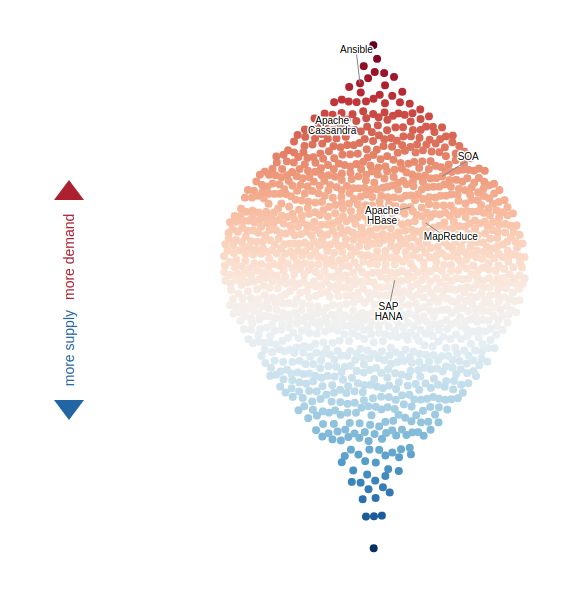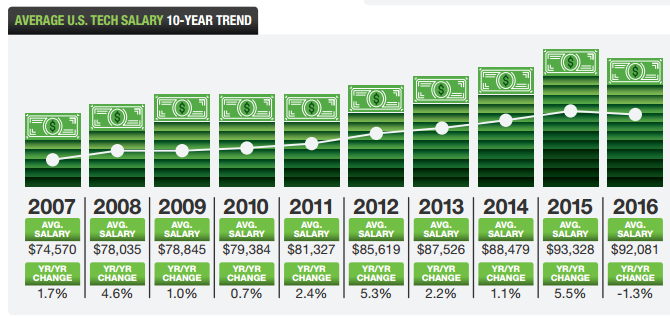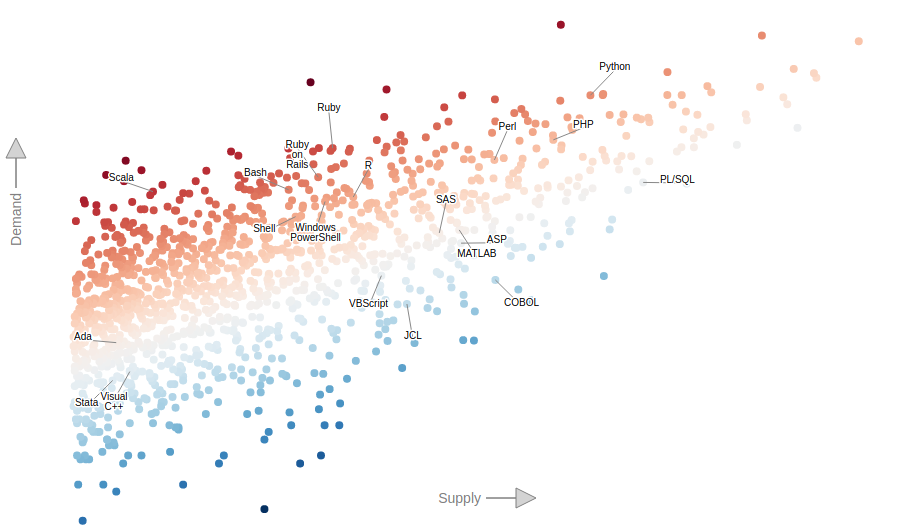Technology
The Most Valuable Tech Skills in 2017
The Most Valuable Tech Skills
The interactive graphic above comes to us from Dice Insights, and it helps to visualize the relationship between the supply and demand for over 1,400 technology skills.
Specifically, the supply shown on the graph is based on the amount of job seekers with those skills available, while demand is the portion of employment opportunities listed that require that skill. The “hotter” red a skill is, the greater the ratio of demand to supply.
Big Data Heats Up
With billions of new “things” connecting to the IoT and an explosion in the amount of information that must be processed and interpreted, it is no surprise that many of the most lucrative skills in tech today relate to making sense of large volumes of data.
Here are the ten highest paying skills in technology, according to Dice:
| Rank | Skill | 2016 Salary | Yr/Yr Change |
|---|---|---|---|
| #1 | HANA | $128,958 | -3.30% |
| #2 | MapReduce | $125,009 | -0.30% |
| #3 | Cloud Foundry | $124,038 | n/a |
| #4 | Hbase | $123,934 | 5.70% |
| #5 | Omnigraffle | $123,782 | -1.90% |
| #6 | Cassandra | $123,459 | 2.20% |
| #7 | Apache Kafka | $122,728 | n/a |
| #8 | SOA | $122,094 | -1.90% |
| #9 | Ansible | $121,382 | n/a |
| #10 | Jetty | $120,978 | 1.30% |
Leading the list is SAP’s HANA, or “High Performance Analytical Application”, which is part of a new wave of databases that can crunch large amounts of data nearly instantly. The average salaries of workers skilled in HANA currently hover around $129,000.
If we sort the members of the top ten most lucrative skills list by “heat” level (with several omissions according to availability in the “heat data” set) we can see that HANA is right in the middle of the plot, where supply is roughly equal to demand. This shows us that tech workers choosing to skill up in HANA are effectively getting paid what they are worth.

Defining the Essentials
What else does “heat” ranking tell us about the market for tech skills that salary data alone does not?
First and foremost, it shows that skills like Java, SQL and HTML, all of which live in the top right-hand corner of the interactive graph where both demand and supply are very high, have become the “bread and butter” of the tech industry. The vast majority of people in the field have a need for these basic services, and as such, the majority of workers in tech have become conversant in them.
We can also see that specific fields, like database administration, web infrastructure management, automation, and big data science, are the areas that businesses need the most help in. The number of specialists skilled in these fields has not yet expanded to meet the significant demand for the associated skills. On the other hand, many marketing and web design skills have fallen toward the “cold” side of the spectrum as supply exceeds demand.
Competition and Timing
Employers may often look for very specific skill sets including one or more of the “hot” skills in the current marketplace. Combined with a hot technology sector, this demand pushes average salary ranges up and motivates tech workers to continually revise their competencies on a regular basis.

With such a fluid marketplace for jobs in technology, unemployment is very low at around 2%. At the same time, over the past decade, the average tech salary has also increased by roughly $17,000.
Brands
How Tech Logos Have Evolved Over Time
From complete overhauls to more subtle tweaks, these tech logos have had quite a journey. Featuring: Google, Apple, and more.

How Tech Logos Have Evolved Over Time
This was originally posted on our Voronoi app. Download the app for free on iOS or Android and discover incredible data-driven charts from a variety of trusted sources.
One would be hard-pressed to find a company that has never changed its logo. Granted, some brands—like Rolex, IBM, and Coca-Cola—tend to just have more minimalistic updates. But other companies undergo an entire identity change, thus necessitating a full overhaul.
In this graphic, we visualized the evolution of prominent tech companies’ logos over time. All of these brands ranked highly in a Q1 2024 YouGov study of America’s most famous tech brands. The logo changes are sourced from 1000logos.net.
How Many Times Has Google Changed Its Logo?
Google and Facebook share a 98% fame rating according to YouGov. But while Facebook’s rise was captured in The Social Network (2010), Google’s history tends to be a little less lionized in popular culture.
For example, Google was initially called “Backrub” because it analyzed “back links” to understand how important a website was. Since its founding, Google has undergone eight logo changes, finally settling on its current one in 2015.
| Company | Number of Logo Changes |
|---|---|
| 8 | |
| HP | 8 |
| Amazon | 6 |
| Microsoft | 6 |
| Samsung | 6 |
| Apple | 5* |
Note: *Includes color changes. Source: 1000Logos.net
Another fun origin story is Microsoft, which started off as Traf-O-Data, a traffic counter reading company that generated reports for traffic engineers. By 1975, the company was renamed. But it wasn’t until 2012 that Microsoft put the iconic Windows logo—still the most popular desktop operating system—alongside its name.
And then there’s Samsung, which started as a grocery trading store in 1938. Its pivot to electronics started in the 1970s with black and white television sets. For 55 years, the company kept some form of stars from its first logo, until 1993, when the iconic encircled blue Samsung logo debuted.
Finally, Apple’s first logo in 1976 featured Isaac Newton reading under a tree—moments before an apple fell on his head. Two years later, the iconic bitten apple logo would be designed at Steve Jobs’ behest, and it would take another two decades for it to go monochrome.
-

 Green1 week ago
Green1 week agoRanked: The Countries With the Most Air Pollution in 2023
-

 Automotive2 weeks ago
Automotive2 weeks agoAlmost Every EV Stock is Down After Q1 2024
-

 AI2 weeks ago
AI2 weeks agoThe Stock Performance of U.S. Chipmakers So Far in 2024
-

 Markets2 weeks ago
Markets2 weeks agoCharted: Big Four Market Share by S&P 500 Audits
-

 Real Estate2 weeks ago
Real Estate2 weeks agoRanked: The Most Valuable Housing Markets in America
-

 Money2 weeks ago
Money2 weeks agoWhich States Have the Highest Minimum Wage in America?
-

 AI2 weeks ago
AI2 weeks agoRanked: Semiconductor Companies by Industry Revenue Share
-

 Travel2 weeks ago
Travel2 weeks agoRanked: The World’s Top Flight Routes, by Revenue















